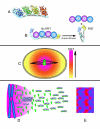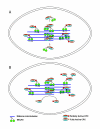Self-organization of intracellular gradients during mitosis
- PMID: 20181052
- PMCID: PMC2829544
- DOI: 10.1186/1747-1028-5-5
Self-organization of intracellular gradients during mitosis
Abstract
Gradients are used in a number of biological systems to transmit spatial information over a range of distances. The best studied are morphogen gradients where information is transmitted over many cell lengths. Smaller mitotic gradients reflect the need to organize several distinct events along the length of the mitotic spindle. The intracellular gradients that characterize mitosis are emerging as important regulatory paradigms. Intracellular gradients utilize intrinsic auto-regulatory feedback loops and diffusion to establish stable regions of activity within the mitotic cytosol. We review three recently described intracellular mitotic gradients. The Ran GTP gradient with its elaborate cascade of nuclear transport receptors and cargoes is the best characterized, yet the dynamics underlying the robust gradient of Ran-GTP have received little attention. Gradients of phosphorylation have been observed on Aurora B kinase substrates both before and after anaphase onset. In both instances the phosphorylation gradient appears to result from a soluble gradient of Aurora B kinase activity. Regulatory properties that support gradient formation are highlighted. Intracellular activity gradients that regulate localized mitotic events bare several hallmarks of self-organizing biologic systems that designate spatial information during pattern formation. Intracellular pattern formation represents a new paradigm in mitotic regulation.
Figures











Similar articles
-
Late mitotic functions of Aurora kinases.Chromosoma. 2017 Feb;126(1):93-103. doi: 10.1007/s00412-016-0594-5. Epub 2016 Apr 22. Chromosoma. 2017. PMID: 27106516 Review.
-
Spatial organization of the Ran pathway by microtubules in mitosis.Proc Natl Acad Sci U S A. 2016 Aug 2;113(31):8729-34. doi: 10.1073/pnas.1607498113. Epub 2016 Jul 20. Proc Natl Acad Sci U S A. 2016. PMID: 27439876 Free PMC article.
-
Visualization of a Ran-GTP gradient in interphase and mitotic Xenopus egg extracts.Science. 2002 Mar 29;295(5564):2452-6. doi: 10.1126/science.1068798. Science. 2002. PMID: 11923538
-
RanBP1 controls the Ran pathway in mammalian cells through regulation of mitotic RCC1 dynamics.Cell Cycle. 2020 Aug;19(15):1899-1916. doi: 10.1080/15384101.2020.1782036. Epub 2020 Jun 28. Cell Cycle. 2020. PMID: 32594833 Free PMC article.
-
Spatial gradients controlling spindle assembly.Biochem Soc Trans. 2015 Feb;43(1):7-12. doi: 10.1042/BST20140243. Biochem Soc Trans. 2015. PMID: 25619240 Review.
Cited by
-
Regulation and coordination of nuclear envelope and nuclear pore complex assembly.Nucleus. 2013 Mar-Apr;4(2):105-14. doi: 10.4161/nucl.23796. Epub 2013 Feb 14. Nucleus. 2013. PMID: 23412657 Free PMC article.
-
The Slow Mobility of the ParA Partitioning Protein Underlies Its Steady-State Patterning in Caulobacter.Biophys J. 2016 Jun 21;110(12):2790-2799. doi: 10.1016/j.bpj.2016.05.014. Biophys J. 2016. PMID: 27332137 Free PMC article.
-
Regulatory mechanisms that control mitotic kinesins.Exp Cell Res. 2015 May 15;334(1):70-7. doi: 10.1016/j.yexcr.2014.12.015. Epub 2015 Jan 6. Exp Cell Res. 2015. PMID: 25576382 Free PMC article. Review.
-
Polo-like Kinase Couples Cytoplasmic Protein Gradients in the C. elegans Zygote.Curr Biol. 2018 Jan 8;28(1):60-69.e8. doi: 10.1016/j.cub.2017.11.048. Epub 2017 Dec 21. Curr Biol. 2018. PMID: 29276126 Free PMC article.
-
Revisiting HIV-1 uncoating.Retrovirology. 2010 Nov 17;7:96. doi: 10.1186/1742-4690-7-96. Retrovirology. 2010. PMID: 21083892 Free PMC article. Review.
References
LinkOut - more resources
Full Text Sources
Miscellaneous

